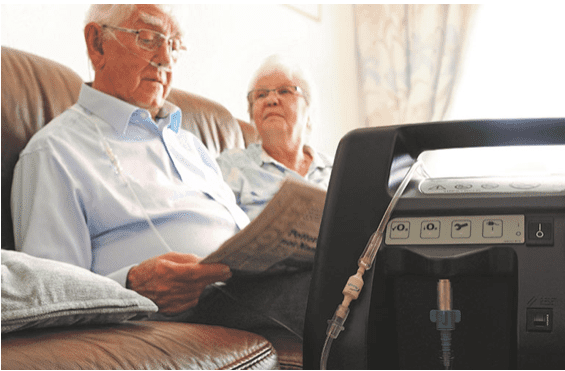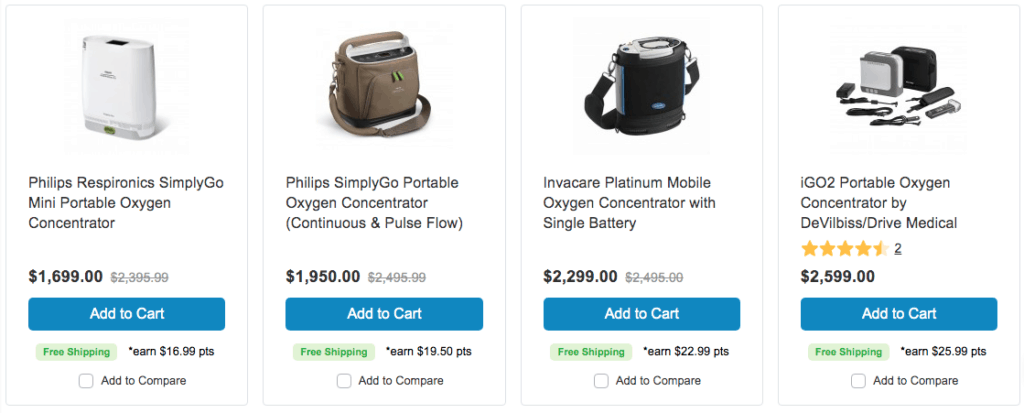
Oxygen concentrators are medical devices that compress the surrounding air to give you a more pure concentrated form of oxygen. The flow of oxygen is continuous as long as the oxygen machine is plugged into an electrical outlet or has a powered battery.
Some of the conditions that may cause someone to experience low oxygen levels include recovery from surgery, COPD, sleep apnea, and anemia. An easy way to increase oxygen levels in your blood is to have a portable oxygen machine or an oxygen concentrator. They work because they draw in the air around them, compress it, and use a sieve bed to filter out the nitrogen which often leaves behind 90% pure oxygen. After that the pure oxygen can be inhaled with a mask or the nasal cannula.
These devices can be especially useful for people who are living with asthma or seniors who may have low oxygen levels in their blood. The reason is due to the fact that portable oxygen generators are lighter and easier to use than standard oxygen tanks which are often heavier and bulkier to move around. This provides a solution for those who need it outside of their home, as well as those who travel.
Below is an example of some of the types of oxygen concentrators that you can purchase for home use.

There are other notable differences that we will explore below. We briefly discuss these six differences:
1. flow rate of medical grade oxygen
2. range of inhaled oxygen concentration
3. the main applicable population
4.compatibility with non-invasive ventilator
5. able to withstand the workload
6. domestic market conditions
1. The medical-grade oxygen flow range of the 3-liter and 5-liter machines is different
3 liter oxygen flow is when the oxygen flow rate is 1~3 liters, the “oxygen concentration” reaches 90%~96%, that is: the oxygen flow rate per minute of the 3 liter oxygen machine, the user chooses 1 liter per minute , 2 liters per minute, 3 liters per minute, it can provide oxygen with an oxygen concentration of 90% ~ 96%. It should be noted that some 3 liter oxygen generators can be adjusted to 4 liters and 5 liters of gas, but in this case, the oxygen output concentration of the machine is no longer 90%~96%. The increase in oxygen concentration will decrease to about 70% at 5 liters. 5 liter oxygen generator, when the oxygen flow rate is selected from 1 to 5 liters, the “oxygen concentration” reaches 90% to 96%, that is, the 5 liter oxygen generator not only includes: the oxygen flow rate per minute is selected as 1 liter, At 2 liters and 3 liters, its oxygen concentration is 90% to 96%; at the same time, when it chooses 4 liters per minute and 5 liters per minute, it can provide oxygen therapy with an oxygen concentration of 90% to 96% oxygen.
2. The range of FiO2 values for the “inhaled oxygen concentration” of the 3-liter and 5-liter engines is different
What is the inhaled oxygen concentration FiO2? FiO2 is the English abbreviation of Fraction of inspiration O2. Chinese is interpreted as the fraction of oxygen concentration in the inhaled gas, referred to as the inhaled oxygen concentration. Commonly used to indicate the percentage of oxygen in the alveoli that participates in gas exchange.
Because: 3 liter oxygen generator and 5 liter oxygen generator, the range of medical oxygen flow is different, so when you use the most common nasal oxygen tube (also called: nasal catheter, nasal suction tube) this device for oxygen inhalation At this time, the concentration of inhaled oxygen FiO2 is different due to the flow of inhaled oxygen.
“Standard nasal oxygen tube” is a low-flow oxygen inhalation device. It is commonly used for oxygen therapy up to 6 liters/minute. It belongs to open oxygen inhalation. The actual oxygen concentration reaching the lungs is: after the oxygen of the oxygen generator is mixed with air Oxygen concentration.
Nasal oxygen tube inhalation method. If the most common nasal oxygen tube is used for oxygen inhalation, the formula for obtaining the estimated value of inhaled oxygen concentration FiO2 from the oxygen flow rate and oxygen concentration is:
Estimated value of inhaled oxygen concentration FiO2 = 21% + 4 × oxygen flow per minute (liter) × oxygen concentration of oxygen generator (%)
From the above formula, we can get the corresponding data of the estimated oxygen flow rate and the FiO2 (inhaled oxygen concentration) of the 3-liter domestic oxygen generator: oxygen flow rate (l/min) oxygen concentration (%) FiO2 estimated value ( With nasal oxygen tube)
1 l/min 90% ~ 96% 24.6% ~ 24.84%
2 liters/min 90% ~ 96% 28.2% ~ 28.68%
3 liters/min 90% ~ 96% 31.8% ~ 32.52%
Similarly, we can also get the corresponding data of the 5-liter home oxygen generator, the oxygen flow rate and FiO2 (inhaled oxygen concentration) estimated value:
Oxygen flow rate (l/min) Oxygen concentration (%) FiO2 estimated value (with nasal oxygen tube)
1 liters/min 90% ~ 96% 24.6% ~ 24.84%
2 liters/min 90% ~ 96% 28.2% ~ 28.68%
3 liters/min 90% ~ 96% 31.8% ~ 32.52%
4 liters/min 90% ~ 96% 35.4% ~ 36.36%
5 liters/min 90% ~ 96% 39.0% ~ 40.20%
3. The applicable population of 3 liter oxygen generator and 5 liter oxygen concentrator is different
The 1 liter and 2 liter oxygen generators are mostly used for health-care oxygen inhalation for people with mild hypoxia, such as pregnant women and white-collar workers with mild hypoxia.
The 3-liter oxygen generator is mostly used for people with mild to moderate respiratory diseases, cardiovascular and cerebrovascular diseases, and three highs.
The 5-liter oxygen generator is mainly used for: severely ill patients, people who need to use ventilator, and people who need long-term oxygen inhalation every day: COPD, lung fiber, lung resection, lung cancer, pneumoconiosis, silicosis and other people.
4. three oxygen machine and five oxygen machine for different people
The 1 liter and 2 liter oxygen generators are mainly used for health oxygen inhalation for people with mild hypoxia, such as pregnant women and white-collar workers with mild hypoxia.
The 3-liter oxygen generator is mainly used for: mild to moderate respiratory diseases, cardiovascular and cerebrovascular diseases, and the three high crowds.
The 5-liter oxygen generator is mainly used for critically ill patients, people who need to use a ventilator, and people who need long-term oxygen inhalation every day: copd, lung fiber, pneumonectomy, lung cancer, pneumoconiosis, silicosis and other people.
Helicopters and helicopter compatible “non-invasive home ventilator” will be different.
Household non-invasive ventilators are different from those used in hospitals. The oxygen source is usually provided by an additional oxygen generator, because the mask has the “storage effect” of carbon dioxide, and the pressure in the mask is relatively large, generally less than the oxygen flow rate of 5 liters/minute, and oxygen cannot enter the mask well. So naturally it cannot enter the airways and lungs, nor can it expel the exhaled carbon dioxide from the mask.
5. The compatibility of the 3-liter machine and 5-liter machine to the “domestic non-invasive ventilator” is different
The non-invasive ventilator used in homes is different from the non-invasive ventilator used in hospitals. The oxygen source is often provided by an additional oxygen generator, because the mask has a “storage effect” of carbon dioxide, and the pressure in the mask is relatively large, generally less than 5 liters/ At a minute oxygen flow rate, oxygen cannot enter the mask well, so naturally it cannot enter the airway and lungs, nor can it expel the exhaled carbon dioxide out of the mask.
In addition, due to the large air flow in the mask, the incoming oxygen will be severely diluted. Therefore, if the low-flow oxygen output of the 3-liter oxygen generator is connected to a non-invasive domestic ventilator, it often cannot meet the patient’s oxygen demand, which affects the patient’s treatment effect.
Therefore, when patients need to connect a home-use non-invasive ventilator to an oxygen generator, doctors often suggest that they need at least a 5-liter home oxygen generator or a larger flow oxygen generator to be more appropriate.
6. The molecular sieve dosage and compressor performance of the 3-liter and 5-liter machines are different, and the work load they can bear is different.
Generally speaking, the amount of molecular sieve filled in a 5-liter oxygen generator is more than that of a 3-liter oxygen generator. At the same time, its power components are also the main cost. The air compressor in the oxygen generator can withstand the work. More load. More suitable for people who need long-term oxygen therapy every day. For example, for people with COPD, they should use a 5 liter oxygen generator more than a 3 liter oxygen generator.
In the flow of oxygen inhalation, people with COPD should take a low flow rate: 1.5 to 2.5 liters of oxygen per minute for oxygen therapy, which will make some people think that as long as 3 liters of oxygen generator is enough, however, in oxygen inhalation In terms of time, for people with COPD, the amount of oxygen therapy required per day is relatively long. They are often advised that the daily oxygen therapy should not be less than 15 hours. If allowed, it is best to 24 Oxygen inhalation.
3 liter oxygen generator, only 1.5 to 2.5 liters per minute, the air compressor on the 3 liter machine has carried a certain workload, and then 15 hours or 24 hours of long-term work, which makes the life of the compressor A sharp drop can easily lead to machine failure.
5 liter oxygen generator, many companies have designed the 5 liter oxygen generator as a 24-hour operation mechanism, the displacement of the compressor is greater, the performance is stronger, when choosing 1.5~2.5 liters, because the 5 liter compressor It has a larger displacement and more surplus. Although the displacement of the 5-liter compressor has been attenuated during a long period of operation, it can also meet the minimum requirements of the system and have a longer overall life. This kind of oxygen inhalation mode for people with COPD is more stable and suitable. This is an important reason why many professional physicians recommend that they use a 5-liter oxygen generator.
In particular, for users who turn on the phone for 15 hours or 24 hours, they often also take oxygen during the night rest. Among the 5-liter oxygen generators, there are many high-end silent and high-quality oxygen generators. , To better meet their oxygen needs.
The Editorial Team at Healthcare Business Today is made up of skilled healthcare writers and experts, led by our managing editor, Daniel Casciato, who has over 25 years of experience in healthcare writing. Since 1998, we have produced compelling and informative content for numerous publications, establishing ourselves as a trusted resource for health and wellness information. We offer readers access to fresh health, medicine, science, and technology developments and the latest in patient news, emphasizing how these developments affect our lives.







